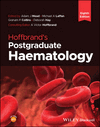Indolent non-Hodgkin lymphomas
Kim Linton
The Christie Hospital NHS Foundation Trust, Department of Medical Oncology and The University of Manchester, Division of Cancer Sciences, Manchester, UK
Search for more papers by this authorWilliam Townsend
University College Hospitals NHS Foundation Trust, Department of Haematology and University College London Clinical Trials Centre, London, UK
Search for more papers by this authorKim Linton
The Christie Hospital NHS Foundation Trust, Department of Medical Oncology and The University of Manchester, Division of Cancer Sciences, Manchester, UK
Search for more papers by this authorWilliam Townsend
University College Hospitals NHS Foundation Trust, Department of Haematology and University College London Clinical Trials Centre, London, UK
Search for more papers by this authorAdam J Mead PhD, FRCP, FRCPath, FMedSci
Haematopoietic Stem Cell Biology Laboratory, Medical Research Council Molecular Haematology Unit, Medical Research Council Weatherall Institute of Molecular Medicine, University of Oxford, Oxford, UK
Search for more papers by this authorMichael A Laffan DM, MRCP, FRCPath
Department of Immunology and Inflammation, Faculty of Medicine, Imperial College London, London, UK
Search for more papers by this authorGraham P Collins DPhil, FRCP, FRCPath
Department of Haematology, Oxford Cancer and Haematology Centre, Oxford, UK
Search for more papers by this authorDeborah Hay DPhil, MRCP, FRCPath
Nuffield Division of Clinical Laboratory Sciences, Radcliffe Department of Medicine, University of Oxford, Oxford, UK
Search for more papers by this authorA Victor Hoffbrand MA, DM, FRCP, FRCPath, FRCP (Edin), DSc, FMedSci
Emeritus Professor of Haematology Honorary Consultant Haematologist
University College London, London, UK
Royal Free Hospital, London, UK
Search for more papers by this authorSummary
The indolent or low-grade B-cell non-Hodgkin lymphomas covered in this chapter are follicular lymphoma, marginal zone lymphoma, Waldenström macroglobulinaemia (lymphoplasmacytic lymphoma) and mantle cell lymphoma. These represent a diverse group of malignancies with distinct epidemiology, pathogenesis, morphologic, immunophenotypic and clinical features. Treatment is different for each subtype. The indolent NHLs are typically considered incurable but, with modern therapeutic approaches, long remissions are possible and a subset of patients may be cured. Better understanding of the pathophysiology of these diseases has led to the search for better tools for accurate diagnosis and prognostication, and personalisation of treatment is being developed with the aim to maximise the durability of remissions whilst limiting toxicity. A range of new therapeutic strategies is emerging that stands to change the treatment paradigm and prognosis for patients with these disorders. This chapter summarises the evidence-based modern approaches to management and includes a selected bibliography for further reading.
Selected bibliography
- Ardeshna KM , Qian W , Smith P et al . ( 2014 ) Rituximab versus a watch-and-wait approach in patients with advanced-stage, asymptomatic, non-bulky follicular lymphoma: an open-label randomised phase 3 trial . The Lancet Oncology 15 ( 4 ): 424 – 35 .
- Bachy E , Seymour JF , Feugier P et al . ( 2019 ) Sustained progression-free survival benefit of rituximab maintenance in patients with follicular lymphoma: long-term results of the PRIMA study . Journal of Clinical Oncology 37 ( 31 ): 2815 – 2824 .
- Cheson BD , Fisher RI , Barrington SF et al . ( 2014 ) Recommendations for initial evaluation, staging, and response assessment of Hodgkin and Non-Hodgkin lymphoma: the lugano classification . Journal of Clinical Oncology 32 ( 27 ): 3059 – 68 .
- Kastritis E , Leblond V , Dimopoulos MA et al . ( 2019 ) Waldenström's macroglobulinaemia: ESMO clinical practice guidelines for diagnosis, treatment and follow-up . Annals of Oncology 30 ( 5 ): 860 – 2 .
- Leonard JP , Trneny M , Izutsu K et al . ( 2019 ) AUGMENT: a phase III Study of Lenalidomide Plus Rituximab Versus Placebo Plus Rituximab in Relapsed or Refractory Indolent Lymphoma . Journal of Clinical Oncology 37 ( 14 ): 1188 – 99 .
- Marcus R , Davies A , Ando K et al . ( 2017 ) Obinutuzumab for the first-line treatment of follicular lymphoma . The New England Journal of Medicine 377 ( 14 ): 1331 – 44 .
- McNamara C , Montoto S , Eyre TA et al . ( 2020 ) The investigation and management of follicular lymphoma . British Journal of Haematology 191 ( 3 ): 363 – 81 .
- Silkenstedt E , Linton K , Dreyling M ( 2021 ) Mantle cell lymphoma – advances in molecular biology, prognostication and treatment approaches . British Journal of Haematology https://doi.org/10.1111/bjh.17419 . Epub ahead of print
- Tam CS , Opat S , D'Sa S et al . ( 2020 ) A randomized phase 3 trial of zanubrutinib vs ibrutinib in symptomatic Waldenström macroglobulinemia: the ASPEN study . Blood 136 ( 18 ): 2038 – 2050 .
- Wang M , Munoz J , Goy A et al . ( 2020 ) KTE-X19 CAR T-Cell Therapy in Relapsed or Refractory Mantle-Cell Lymphoma . The New England Journal of Medicine 382 ( 14 ): 1331 – 1342 .
- Zucca E , Arcaini L , Buske C et al . ( 2019 ) Marginal zone lymphomas: ESMO Clinical Practice Guidelines for diagnosis, treatment and follow-up . Annals of Oncology 31 ( 1 ): 17 – 29 .



